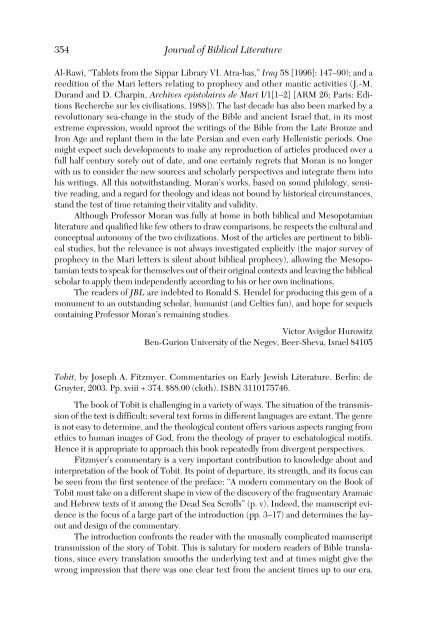Journal of Biblical Literature - Society of Biblical Literature
Journal of Biblical Literature - Society of Biblical Literature
Journal of Biblical Literature - Society of Biblical Literature
Create successful ePaper yourself
Turn your PDF publications into a flip-book with our unique Google optimized e-Paper software.
354 <strong>Journal</strong> <strong>of</strong> <strong>Biblical</strong> <strong>Literature</strong><br />
Al-Rawi, “Tablets from the Sippar Library VI. Atra-has,” Iraq 58 [1996]: 147–90); and a<br />
reedition <strong>of</strong> the Mari letters relating to prophecy and other mantic activities (J.-M.<br />
Durand and D. Charpin, Archives epistolaires de Mari I/1[1–2] [ARM 26; Paris: Editions<br />
Recherche sur les civilisations, 1988]). The last decade has also been marked by a<br />
revolutionary sea-change in the study <strong>of</strong> the Bible and ancient Israel that, in its most<br />
extreme expression, would uproot the writings <strong>of</strong> the Bible from the Late Bronze and<br />
Iron Age and replant them in the late Persian and even early Hellenistic periods. One<br />
might expect such developments to make any reproduction <strong>of</strong> articles produced over a<br />
full half century sorely out <strong>of</strong> date, and one certainly regrets that Moran is no longer<br />
with us to consider the new sources and scholarly perspectives and integrate them into<br />
his writings. All this notwithstanding, Moran’s works, based on sound philology, sensitive<br />
reading, and a regard for theology and ideas not bound by historical circumstances,<br />
stand the test <strong>of</strong> time retaining their vitality and validity.<br />
Although Pr<strong>of</strong>essor Moran was fully at home in both biblical and Mesopotamian<br />
literature and qualified like few others to draw comparisons, he respects the cultural and<br />
conceptual autonomy <strong>of</strong> the two civilizations. Most <strong>of</strong> the articles are pertinent to biblical<br />
studies, but the relevance is not always investigated explicitly (the major survey <strong>of</strong><br />
prophecy in the Mari letters is silent about biblical prophecy), allowing the Mesopotamian<br />
texts to speak for themselves out <strong>of</strong> their original contexts and leaving the biblical<br />
scholar to apply them independently according to his or her own inclinations.<br />
The readers <strong>of</strong> JBL are indebted to Ronald S. Hendel for producing this gem <strong>of</strong> a<br />
monument to an outstanding scholar, humanist (and Celtics fan), and hope for sequels<br />
containing Pr<strong>of</strong>essor Moran’s remaining studies.<br />
Victor Avigdor Hurowitz<br />
Ben-Gurion University <strong>of</strong> the Negev, Beer-Sheva, Israel 84105<br />
Tobit, by Joseph A. Fitzmyer. Commentaries on Early Jewish <strong>Literature</strong>. Berlin: de<br />
Gruyter, 2003. Pp. xviii + 374. $88.00 (cloth). ISBN 3110175746.<br />
The book <strong>of</strong> Tobit is challenging in a variety <strong>of</strong> ways. The situation <strong>of</strong> the transmission<br />
<strong>of</strong> the text is difficult; several text forms in different languages are extant. The genre<br />
is not easy to determine, and the theological content <strong>of</strong>fers various aspects ranging from<br />
ethics to human images <strong>of</strong> God, from the theology <strong>of</strong> prayer to eschatological motifs.<br />
Hence it is appropriate to approach this book repeatedly from divergent perspectives.<br />
Fitzmyer’s commentary is a very important contribution to knowledge about and<br />
interpretation <strong>of</strong> the book <strong>of</strong> Tobit. Its point <strong>of</strong> departure, its strength, and its focus can<br />
be seen from the first sentence <strong>of</strong> the preface: “A modern commentary on the Book <strong>of</strong><br />
Tobit must take on a different shape in view <strong>of</strong> the discovery <strong>of</strong> the fragmentary Aramaic<br />
and Hebrew texts <strong>of</strong> it among the Dead Sea Scrolls” (p. v). Indeed, the manuscript evidence<br />
is the focus <strong>of</strong> a large part <strong>of</strong> the introduction (pp. 3–17) and determines the layout<br />
and design <strong>of</strong> the commentary.<br />
The introduction confronts the reader with the unusually complicated manuscript<br />
transmission <strong>of</strong> the story <strong>of</strong> Tobit. This is salutary for modern readers <strong>of</strong> Bible translations,<br />
since every translation smooths the underlying text and at times might give the<br />
wrong impression that there was one clear text from the ancient times up to our era.

















